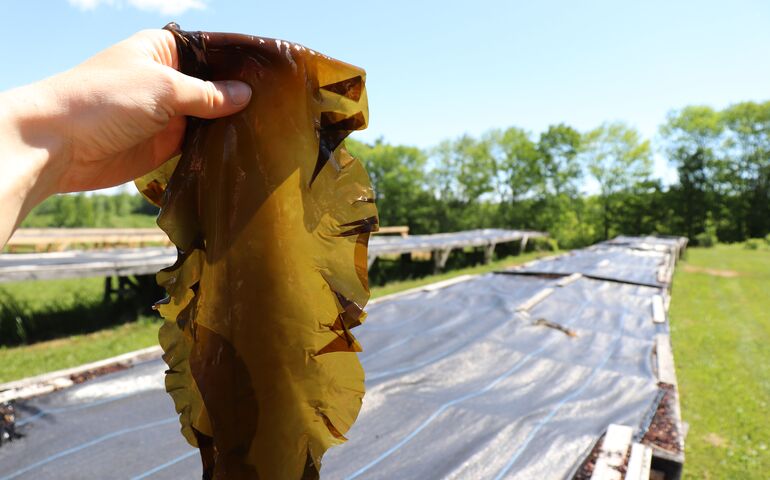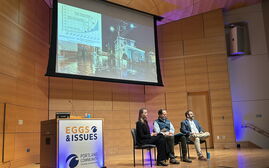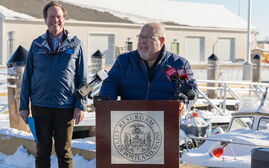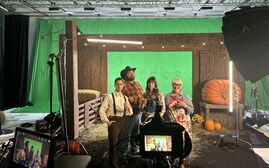
Aquaculture group releases first benchmarking report, business planning tools
 Courtesy / Maine Aquaculture Association
Maine’s aquaculture industry is growing, thanks to interest from veteran commercial fishermen and young entrepreneurs alike. Seen here is sugar kelp, farmed by Nautical Farms in Machias and photographed at Broadturn Farm in Scarborough where its was sun-dried for processing earlier this spring.
Courtesy / Maine Aquaculture Association
Maine’s aquaculture industry is growing, thanks to interest from veteran commercial fishermen and young entrepreneurs alike. Seen here is sugar kelp, farmed by Nautical Farms in Machias and photographed at Broadturn Farm in Scarborough where its was sun-dried for processing earlier this spring.
The Maine Aquaculture Association has released what it calls a first-of-its-kind financial benchmarking report for the industry, as well as new planning and risk management tools for aquaculture businesses.
The new resources and two new hires represent a concentrated effort to grow Maine’s aquaculture sector, the association’s executive director, Sebastian Belle, told Mainebiz.
“For many years we’ve been resource-constrained,” Belle said.
The Maine Aquaculture Association was established in 1978 as a nonprofit trade association that advocates for Maine’s aquatic farmers — including shellfish, finfish and sea vegetable producers — at the state, federal, and international levels. It was the first aquatic farmers’ association in the U.S., according to its website.
Fighting brushfires
Belle was hired in 1989.
“For many years it was one person, then only two of us,” he said. “A couple of years ago, I went to the board and said ‘Folks, we are working, basically, 24/7.’ I was hired by the board to make the association be more proactive, not to always be fighting brushfires.”
Belle had identified a need to support an influx of new growers coming into the field, and provide them with business tools and counseling.
“I said, ‘If we don’t do that, we’ll have a lot of farmers who will fail,’” he continued.
At the same time, he said, the industry needed to tell its story as part of its marketing plan.
“We have the most amazing folks in the world starting these farms, building businesses, employing young people and creating cool, dynamic entrepreneurial companies,” he said.
Into the 21st century
About a year ago, the board authorized Belled to hire Christian Brayden as project manager and Afton Hupper as outreach and development specialist.
“We needed to come into the 21st century,” said Belle. “The most important thing is it was the growers themselves who agreed to raise their dues and invest more in the sector collectively.”
How much interest is there in the sector?
“It’s exploding,” said Belle.
The interest comes from two directions. About a decade ago, the sector began seeing commercial fishermen interested in getting into aquaculture as a supplemental income.
“Since then, we’ve seen a huge increase in the number of commercial fishermen, or the sons and daughters of commercial fishermen who have been unable to get fishing permits,” he said.
About 60% of the association’s membership is now commercial fishermen or come from commercial fishing families.
“That’s a big change from 10 years ago,” Belle said.
Young adults who aren’t from fishing families are also looking to get into the business, he added.
Complementary to those trends, there are a growing number of elementary and high schools that use aquaculture to teach STEM curriculum, he added.
“The educational community has begun to recognize that aquaculture is a cool way to teach kids math and science in a hands-on way,” he said. “There’s quite a bit of activity around that and I think that activity will ramp up quite a bit.”
There’s also an increasing number of opportunities to obtain formal workforce training, he added. That includes certificate, associate and degree programs, such as University of New England’s bachelor's degree in aquaculture and aquarium science.
The association is partnering with Educate Maine and the Gulf of Maine Research Institute, both in Portland, to develop a set of occupational standards linking educational opportunities for career advancement, Belle added.
Although Maine’s aquaculture industry is small, compared with seafood farming elsewhere in the nation and the world, it’s becoming increasingly diversified. Industry experts see opportunity for expansion in various sectors, as well as more jobs, according to an aquaculture workforce development summary released earlier this year by Portland’s Gulf of Maine Research Institute in partnership with the Maine Aquaculture Association and Educate Maine, with support from FocusMaine.
Over the past decade, Maine has seen 2.2% annual growth in aquaculture, which has had an overall economic impact of $140 million annually, according to a University of Maine news release.
Benchmark analysis
Development of the benchmark analysis report and business support tools was funded by the association in partnership with FocusMaine and Maine Technology Institute.
The benchmark report, completed in partnership with aquaculture economists Carole Engle of Engle-Stone Aquatic$ and Jonathan van Senten of the Virginia Seafood Agriculture and Experiment Station, presents results from the calculation of a series of benchmarks designed to serve as guidance for prospective Maine shellfish and seaweed producers.
For example, the guidance might be used in their business planning, as well as by lenders in the evaluation of loan applications.
Maine oyster, mussel, scallop and seaweed farmers were interviewed and provided data based on the 2017 to 2019 growing seasons. Financial performance benchmarks and the types of risks and problems faced by shellfish and seaweed farmers were then summarized. The Maine benchmarks were complemented by a review of the scientific literature and benchmarking studies from elsewhere in the U.S. and the European Union.
Benchmarks were calculated for production, expenses, breakeven prices and yields, profitability, financial, loan repayment, and efficiency (labor, capital, financial). The report can be used for one business to compare its performance with other similar businesses in the sector for a given year. Benchmarks also allow businesses to track which of their categories (i.e. production, expenses, yields) meet, exceed, or fall below industry averages and use that information to increase their profitability.
Financial lenders and investors can also use these benchmarks to identify thresholds to predict financial success or failure of a startup business.
The audience for the work is existing and prospective growers, said Brayden.

“A lot of this work is to foster small aquaculture businesses in Maine,” he said.
The benchmark report is a first for Maine, he added.
“The idea is to develop production, cost efficiencies and profitability benchmarks, develop a summary of the results, and provide it to lenders and loan officers to evaluate business plans and loan proposals,” Brayden said.
As a snapshot of the industry, the report also allows producers to benchmark how their business is performing or could perform, to improve efficiencies and identify red flags, he added.
Business planning tools
The association also released a suite of business planning tools designed to provide Maine aquaculture business owners with updated resources and capabilities to help strengthen their businesses.
Each suite of tools includes software to develop a production plan and a business plan for the grower’s species of choice, complete with user manuals and a two-hour, one-on-one training session.
The project addresses the limited availability of planning resources for aquaculturists looking to start new businesses or improve their current operations in Maine — a state that possesses unique growing conditions and animal growth rates.
The tools, which are available for oysters, mussels, scallops and seaweed with Maine-specific growth rates, are designed to help business owners think through the financial and production planning of their business and put a blueprint in place.
The business plans include features and capabilities such as short- and long-term budget projections and tracking, financial projection and analysis tools, monthly cash flow projections, costs of production analysis, profitability analysis, sensitivity analysis and breakeven analysis. The production plans offer additional features and capabilities such as short and long-term production projections and tracking, data-based growth projections, monthly sales planning and tracking, and a production calendar.
Risk management guide
The association published a series of risk management tools designed to help Maine aquaculture producers find new ways to identify and respond to risk on their farms and in their businesses.
The tools include a white paper and two-pager on risk management and mitigation, along with a two-page beginner’s guide to risk management within each of the five categories of risk: production, financial, marketing, human and legal. The documents include aquaculture crop insurance options. Other topics, such as good record-keeping practices, are also discussed as part of a holistic approach to managing and mitigating risk.
The beginner’s guide to risk management is designed as a series of decision trees to help farmers identify risks, determine tolerance to risks, and explore options to mitigate and manage risks. This guide walks farmers through goal setting, risk tolerance, and risk identification. It also offers solutions within each category of risk to help them take appropriate action.
To access the benchmark report and planning tools, click here.
Online portal
The Maine Aquaculture Association also partnered with the Gulf of Maine Research Institute to design a free-to-use online knowledge portal designed to help Maine’s sea farmers access an array of existing business resources across the state.
The portal is called “The Maine Aquaculturist.” The work was sponsored by FocusMaine.
The centralized portal includes state agencies, NGOs, research labs, academic institutions, trade groups and other organizations invested in the economic potential aquaculture brings to the state. Between these organizations and the farms themselves, there is no shortage of information available — but with so many organizations contributing valuable insight, it can be difficult for farmers to find the information quickly amid all the other demands of their businesses, according to a news release.
The Maine Aquaculturist addresses the challenge by centralizing and organizing the resources to help farmers find information to build and sustain their businesses.
The new platform, launched last month, serves startups and mature aquaculture companies. It includes a startup guide for new aquaculture entrepreneurs and a guide to financing options. For industry veterans, the platform features a searchable resource database, job board and regulatory update tracker.
The site also features case studies that highlight the experiences of industry veterans from diverse backgrounds, who share critical insights to help readers draw from their successes and avoid repeating their mistakes.
The new tool is primarily a response to a gap in industry support identified by aquaculture business owners. A series of working sessions and conversations with aquaculturists from across the industry drove the content, structure, and design of the platform.
To access the portal, click here.














0 Comments